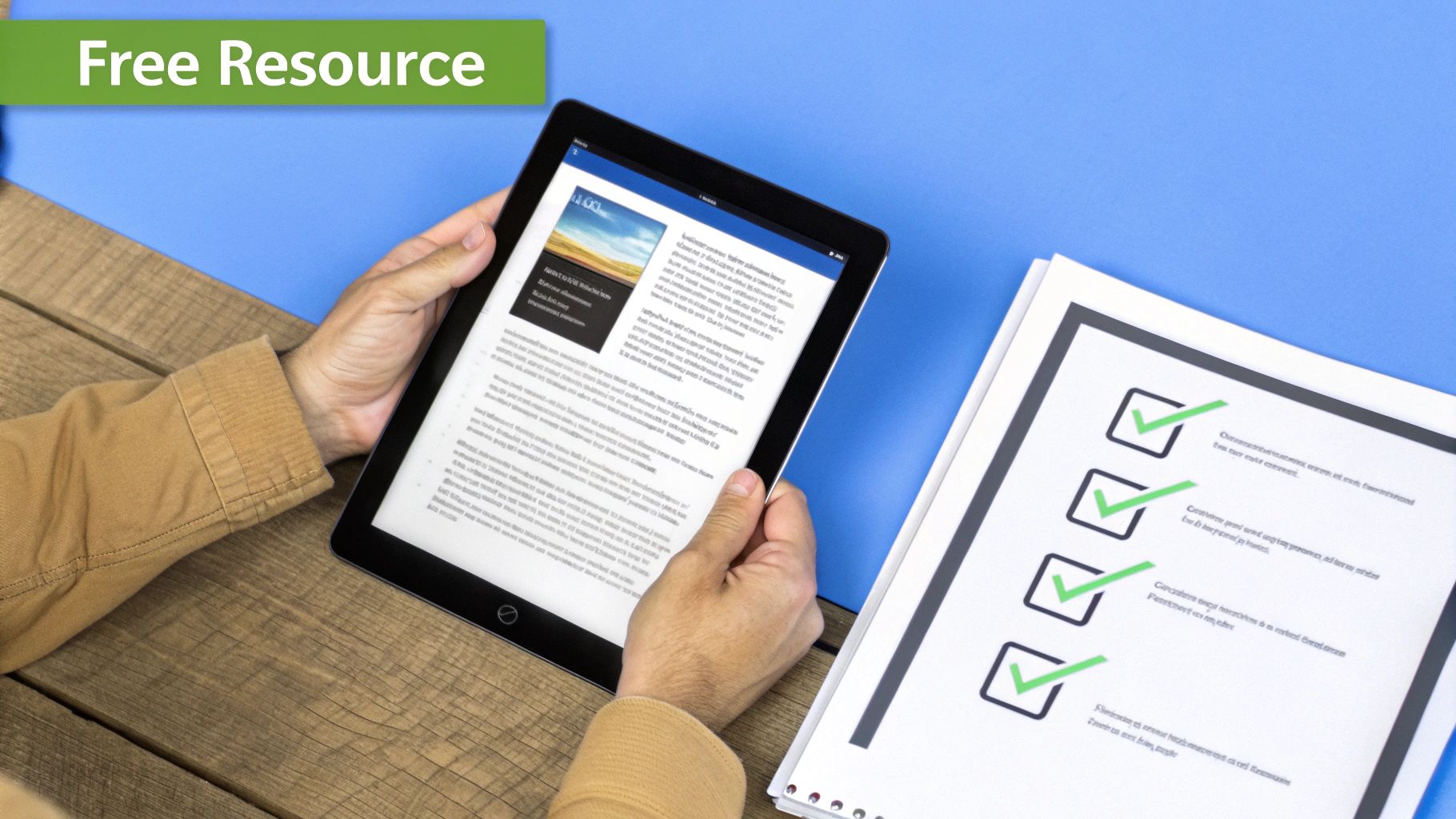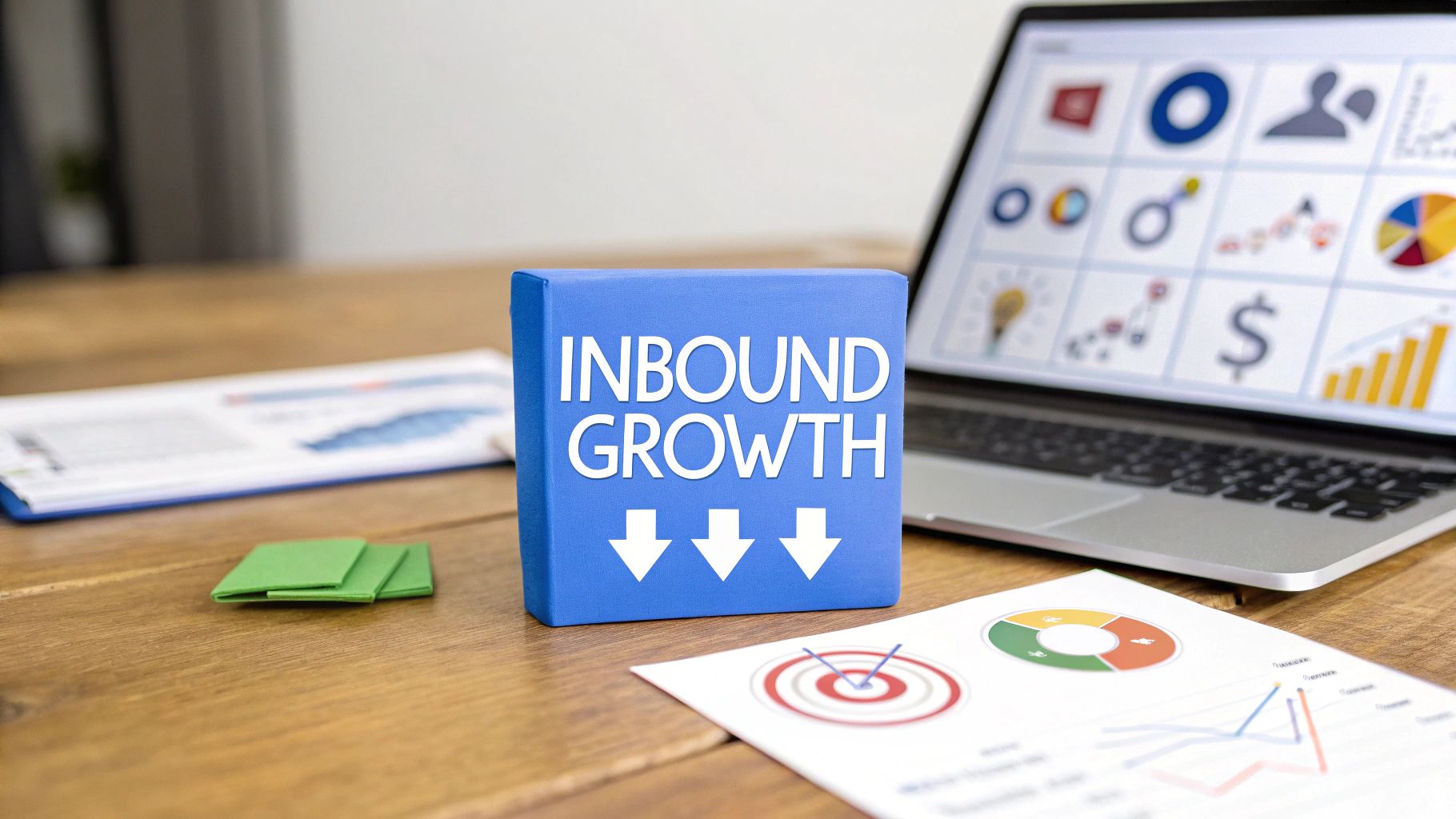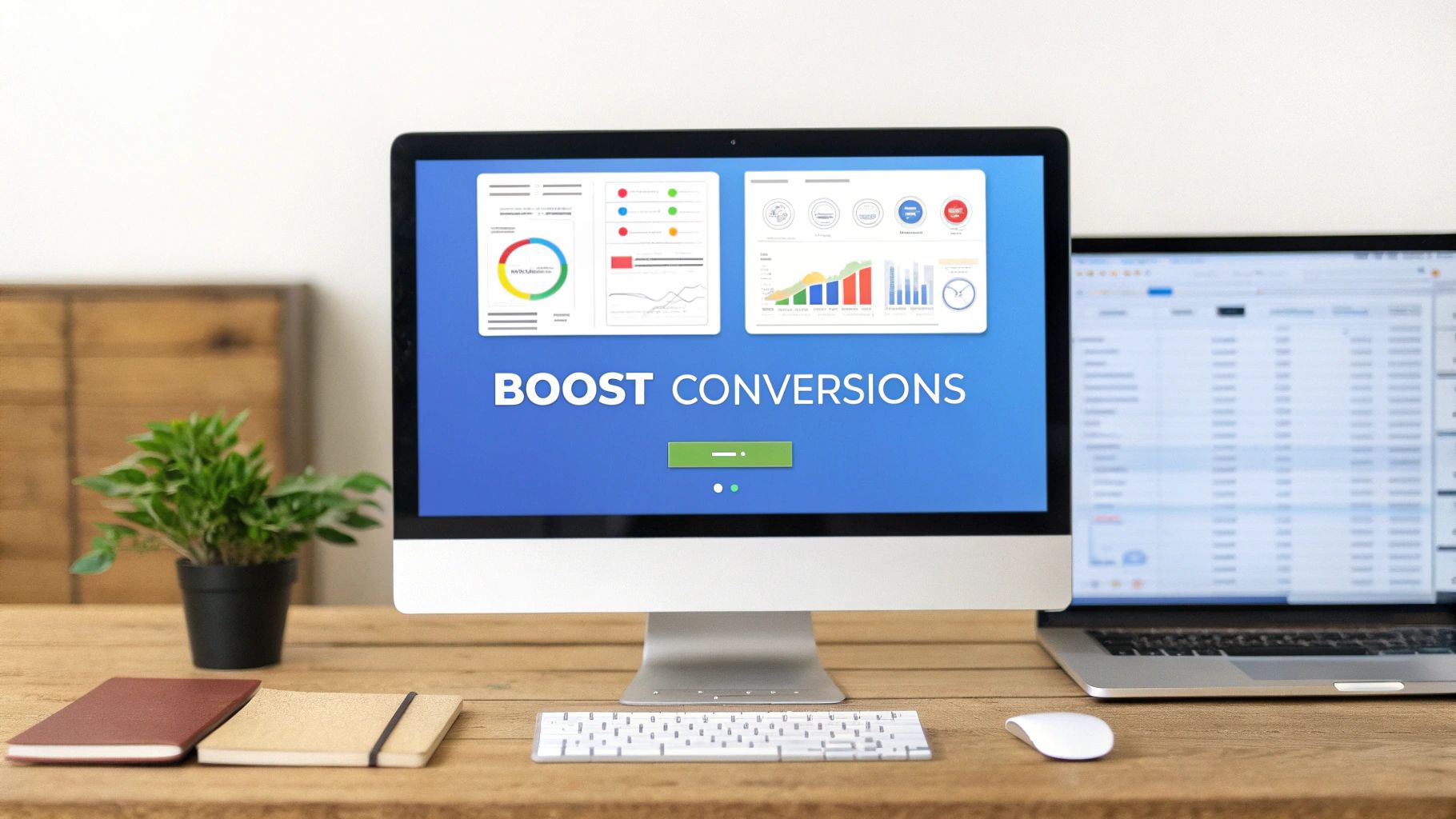Summary
Meta Description: Discover 12 powerful and actionable ideas for lead generation to fill your pipeline. From SEO and content to paid ads and ABM, start converting today.
In today's competitive market, a steady flow of qualified leads is the lifeblood of your business. But with countless channels and tactics available, where should you focus your energy for maximum impact? Many marketers feel stuck, recycling the same old strategies and seeing diminishing returns. This cycle of stagnation prevents growth and can leave your sales pipeline looking alarmingly empty. The key is to move beyond generic advice and implement specific, actionable strategies tailored to your audience.
This article cuts through the noise. We've compiled a comprehensive roundup of 12 proven and innovative ideas for lead generation, designed to help you attract, engage, and convert your ideal customers. We will move beyond surface-level tips to provide a blueprint you can use to build a robust and predictable lead generation engine. Whether you’re a freelance marketer, an e-commerce brand, or a B2B enterprise, these methods are designed for immediate implementation.
We'll cover everything from leveraging SEO and content marketing to mastering paid advertising, community building, and strategic partnerships. For those in highly specialized sectors, exploring efficient methods is crucial. For a deeper dive into specific tactics, consider these 10 Proven SaaS B2B Lead Generation Strategies that work effectively in today's market. Each strategy in our list is broken down into practical steps, ensuring you have the tools to turn theory into tangible results.
Ready to transform your pipeline from empty to overflowing?
1. Content Marketing & SEO: Your Long-Term Lead Engine
Content marketing paired with Search Engine Optimization (SEO) is a foundational strategy for generating high-quality leads consistently. This powerful duo focuses on creating and distributing valuable, relevant content—like blog posts, in-depth guides, and whitepapers—that is optimized to rank on search engines for specific keywords. The core principle is simple: attract an audience that is actively searching for solutions your business provides.

Unlike paid advertising, which stops working the moment you stop paying, a well-optimized piece of content can become a long-term asset. It works around the clock to attract organic traffic, build trust with your audience, and establish your brand as an authority. By directly addressing the pain points of your target customers, you draw in high-intent prospects and guide them toward your products or services.
Why This Idea Works
This is one of the most sustainable ideas for lead generation because it builds a powerful inbound engine. Industry leaders like HubSpot and Backlinko have built their entire marketing funnels on this principle, attracting millions of visitors and generating thousands of leads each month by providing exceptional, problem-solving content. The trust established through this approach makes converting visitors into leads a far more natural and effective process.
How to Get Started With Content for Lead Generation
To get started, follow these best practices:
- Target Long-Tail Keywords: Focus on highly specific, multi-word phrases (e.g., "how to generate real estate leads on facebook") that have lower competition and higher conversion intent.
- Create Content Clusters: Build your authority by creating a central "pillar" page for a broad topic and linking out to more detailed "cluster" articles on related subtopics.
- Update and Refresh Old Content: Keep your best-performing articles relevant by updating statistics, adding new information, and optimizing them for current SEO standards.
- Include Clear CTAs: Embed compelling calls to action (CTAs) for relevant lead magnets, such as ebooks or checklists, within your content to convert readers into leads.
2. Email Marketing & Lead Nurturing: Convert Your Audience
Email marketing and lead nurturing are fundamental to converting prospects into loyal customers. This strategy involves building an email list and sending targeted, personalized campaigns to guide subscribers through the buyer's journey. By delivering value directly to their inbox, you build a relationship, maintain top-of-mind awareness, and gently push leads toward a purchasing decision.
Unlike public-facing social media, email offers a direct and personal line of communication. It allows for deep segmentation and customization, ensuring that the right message reaches the right person at the right time. From welcome sequences to re-engagement campaigns, email automation tools can handle the heavy lifting, making this a scalable and high-ROI channel for businesses of all sizes.
Why This Idea Works
This is one of the most effective ideas for lead generation and conversion because you own the audience. Platforms like Mailchimp and Klaviyo have empowered countless businesses to turn subscribers into buyers through automated email flows. By delivering consistent value, you nurture trust and create a reliable revenue stream that isn't dependent on fluctuating social media algorithms or ad costs. The direct, one-to-one nature of email makes it perfect for personalized nurturing.
How to Nurture Leads Effectively with Email
To get started, follow these best practices:
- Create a Welcome Series: Automate a sequence of 3-5 emails for new subscribers to introduce your brand, set expectations, and provide initial value.
- Segment Your Lists: Group subscribers based on their behavior, demographics, or interests to send highly relevant and personalized content.
- Test and Optimize: Continuously A/B test your subject lines, send times, and call-to-action buttons to improve open rates and conversions.
- Prioritize Mobile-Friendliness: Ensure your emails look great and are easy to read on mobile devices, as a significant portion of users will open them there.
- Integrate Automation: Beyond individual campaigns, integrating small business marketing automation can streamline your efforts, saving time while nurturing leads more effectively.
3. Paid Advertising (PPC, Social, Retargeting): Get Leads Now
Paid advertising offers a direct and highly scalable way to generate leads by placing your message in front of precisely targeted audiences. Platforms like Google Ads, Meta (Facebook and Instagram), and LinkedIn allow you to capture the attention of users based on their search intent, demographics, interests, and professional profiles. This strategy provides immediate visibility and drives qualified traffic directly to dedicated landing pages designed for conversion.
Unlike organic methods that require time to build momentum, paid campaigns can start generating leads from day one. This makes them ideal for launching new products, promoting time-sensitive offers, or supplementing your inbound efforts. By leveraging sophisticated targeting options and retargeting capabilities, you can re-engage warm prospects, recover abandoned carts, and guide potential customers through your sales funnel with tailored ads.
Why This Idea Works
Paid advertising is one of the most effective ideas for lead generation because it delivers speed, control, and precision. Companies like Slack famously used targeted LinkedIn ads in their early days to reach decision-makers at other tech companies, accelerating their growth. Similarly, countless e-commerce brands rely on Facebook and Google retargeting to recapture lost sales. The ability to measure ROI directly by tracking cost per lead and conversions makes it a powerful and accountable marketing channel.
How to Maximize Your Paid Advertising ROI
To maximize your paid advertising ROI, follow these best practices:
- Create Dedicated Landing Pages: Never send paid traffic to your homepage. Design a specific landing page for each campaign with a single, clear call to action to increase conversion rates.
- Use Tightly Themed Ad Groups: In Google Ads, group keywords into highly specific themes to improve your Quality Score, lower costs, and ensure your ad copy is hyper-relevant to the search query.
- Implement Pixel Tracking: Install tracking pixels (like the Meta Pixel or LinkedIn Insight Tag) immediately to build retargeting audiences and track conversions accurately.
- Start with High-Intent Keywords: For PPC, begin with keywords that indicate a strong desire to buy or take action (e.g., "emergency plumbing services near me") to secure quick wins and build momentum.
4. Landing Pages & Lead Capture Forms: The Conversion Hub
Dedicated landing pages with optimized lead capture forms are purpose-built conversion machines. Unlike a standard webpage cluttered with navigation and multiple CTAs, a landing page focuses on a single goal: capturing a visitor's information in exchange for a valuable offer. This laser-focused approach eliminates distractions, making it one of the most effective ideas for lead generation when driving traffic from paid ads, email campaigns, or social media.

By directing prospects to a page tailored specifically to their interests, you dramatically increase the likelihood of conversion. The page reinforces the value proposition they just clicked on, creating a seamless and persuasive user journey. It’s the digital equivalent of a dedicated salesperson guiding a prospect toward a single, desired action.
Why This Idea Works
This strategy works because it aligns perfectly with user intent and minimizes friction. Companies like Unbounce and Leadpages have built entire platforms around this principle, proving that a well-designed landing page can consistently outperform a generic homepage for lead capture. By removing exit paths and presenting a compelling, singular offer, you create a high-pressure, high-value environment that encourages immediate action from qualified prospects.
How to Create Landing Pages That Convert
To create landing pages that convert, implement these tips:
- Remove Navigation: Eliminate the main menu and footer links to keep visitors focused on the conversion goal.
- Use Benefit-Driven Headlines: Write clear, compelling headlines that communicate the value of your offer instantly.
- Keep Forms Short: Ask for essential information only. Limiting fields to 3-5 can significantly boost completion rates.
- Include Social Proof: Add testimonials, case studies, or logos of well-known clients to build trust and credibility. For an in-depth guide, discover more about landing page conversion optimization.
5. Webinars & Virtual Events: Engage and Educate
Hosting webinars and virtual events is a powerful strategy for attracting and engaging high-intent prospects in real time. This approach combines valuable educational content with direct interaction, allowing you to showcase expertise, demonstrate products, and answer questions from a captive audience. By offering in-depth insights on a specific topic, you attract individuals actively seeking solutions and knowledge in your niche.
Unlike static content, live events create a sense of urgency and community, encouraging immediate engagement. The registration process itself is a direct lead-capture mechanism, providing you with a list of contacts who have explicitly raised their hands to learn from you. This direct line of communication makes nurturing these prospects toward a sale significantly more effective.
Why This Idea Works
This is one of the most effective ideas for lead generation because it shortens the sales cycle by building trust and authority at scale. Companies like HubSpot and Gong leverage webinars to educate thousands of potential customers simultaneously, positioning themselves as industry leaders. This format provides immense value upfront, making attendees more receptive to a sales conversation post-event.
How to Execute a Successful Webinar
To execute a successful webinar, follow these best practices:
- Promote Early and Often: Begin promoting your event 2-3 weeks in advance across email, social media, and paid channels to maximize registrations.
- Keep it Concise: Structure your presentation to last between 30-45 minutes, leaving ample time for a live Q&A session to boost engagement.
- Leverage Co-Hosts: Invite an industry expert to co-host, which adds credibility and exposes your event to their audience.
- Follow Up Promptly: Send all registrants a link to the webinar recording and presentation slides within 24 hours to continue nurturing the relationship. Learn more about creating high-converting landing pages for webinars on landermagic.com.
6. Social Media Marketing & Community Building: Foster Loyalty
Social media marketing and community building transform passive followers into active leads by fostering genuine engagement and brand loyalty. This strategy moves beyond simple broadcasting; it involves creating valuable, shareable content and nurturing conversations on platforms like LinkedIn, Instagram, and TikTok. The goal is to build a vibrant community that not only consumes your content but also trusts your brand, making them more likely to convert.
By establishing a strong presence where your audience spends their time, you can guide them from awareness to consideration organically. It’s about more than just follower counts; it's about creating a two-way dialogue that provides value, answers questions, and subtly directs engaged users toward lead-generating assets like webinars, newsletters, or gated content hosted on your website.
Why This Idea Works
This approach is one of the most effective ideas for lead generation because it leverages the power of social proof and authentic connection. Companies like Buffer and Later have excelled at this by not only sharing expert marketing tips but also by actively engaging with their community, responding to comments, and showcasing user-generated content. This builds a loyal following that views the brand as a trusted partner, not just a service provider, leading to higher-quality, warmer leads.
How to Build Your Community and Generate Leads on Social Media
To effectively build your community and generate leads, implement these tips:
- Create Platform-Specific Content: Tailor your content to each platform’s strengths, such as creating educational carousels for Instagram, thought leadership posts for LinkedIn, or engaging short-form videos for TikTok and Reels.
- Engage Proactively: Don't just post and ghost. Respond to all comments and messages promptly, participate in relevant conversations using industry hashtags, and actively ask your audience for their opinions.
- Promote Lead Magnets Natively: Instead of just dropping links, create posts that naturally lead into a call to action (CTA). For example, share a key insight from an ebook and invite followers to download the full guide via the link in your bio.
- Leverage User-Generated Content (UGC): Encourage your audience to share their experiences with your brand and feature their posts. This builds social proof and strengthens the sense of community, making your brand more relatable and trustworthy.
7. Strategic Partnerships & Referral Programs: Leverage Networks
Strategic partnerships and referral programs are a powerful way to tap into new audiences by leveraging the credibility and reach of complementary businesses. This strategy involves collaborating with non-competing companies, influencers, or even satisfied customers to generate warm leads through trusted introductions. Instead of relying on cold outreach, you gain access to a pre-qualified audience that already trusts your partner.
The core concept is mutual benefit. Your business gets high-quality leads, while your partner receives a commission, a reciprocal service, or an enhanced offering for their own customers. This collaborative approach creates a self-sustaining ecosystem where both parties are incentivized to promote one another, driving consistent growth and fostering strong business relationships.
Why This Idea Works
This is one of the most effective ideas for lead generation because it operates on trust, which is a significant conversion factor. Tech giants like Slack and Zapier have built massive user bases through integration partnerships, where each new app connection introduces their platform to another company’s entire audience. Similarly, HubSpot's partner program is a cornerstone of its growth, generating a substantial portion of its revenue through a network of agency and tech partners who refer new customers.
How to Launch a Successful Partnership Program
To launch a successful partnership program, consider these steps:
- Identify Complementary Partners: Find businesses that serve a similar customer profile but offer a non-competing product or service.
- Create a Win-Win Structure: Develop an attractive commission, discount, or co-marketing plan that provides real value to your partners.
- Provide a Partner Toolkit: Equip your partners with marketing materials, co-branded content, and unique tracking links to make promotion easy.
- Track Performance Transparently: Use referral tracking software to monitor leads, conversions, and payouts, ensuring clarity and trust in the partnership.
8. Account-Based Marketing (ABM): Focus on High-Value Targets
Account-Based Marketing (ABM) flips the traditional lead generation funnel on its head. Instead of casting a wide net to capture as many individual leads as possible, ABM focuses marketing and sales resources on a curated list of high-value target accounts. This highly personalized strategy treats each account as its own market, tailoring outreach and content specifically to their unique challenges and decision-makers.
The core principle of ABM is alignment between sales and marketing teams to orchestrate a unified, multi-channel approach. By concentrating efforts on accounts with the highest revenue potential, businesses can deliver a cohesive and compelling buying experience. This method is especially effective for B2B companies with long sales cycles and high-value deals.
Why This Idea Works
ABM is one of the most efficient ideas for lead generation because it eliminates wasted resources on low-quality prospects. Companies like Terminus and 6sense have built their entire platforms around this model, demonstrating its power to drive significant ROI by engaging key stakeholders directly. By personalizing the entire journey, from ads to sales calls, ABM builds stronger relationships and accelerates the sales process with a targeted, high-impact approach.
How to Launch a Successful ABM Campaign
To launch a successful ABM campaign, follow these steps:
- Identify High-Value Accounts: Work with your sales team to select a small, manageable list of 50-100 ideal target companies that fit your customer profile.
- Create Detailed Account Personas: Go beyond standard buyer personas and map out the key decision-makers, influencers, and pain points within each specific account.
- Personalize All Touchpoints: Customize content, ads, emails, and even chatbot conversations to address the specific needs and industry context of the target account.
- Coordinate Multi-Channel Outreach: Align your campaigns across different channels (e.g., LinkedIn ads, personalized emails, direct mail) to create a cohesive and persistent presence.
- Track Account-Level Engagement: Use ABM tools to monitor engagement across the entire account, not just individual leads, to gauge interest and identify buying signals.
9. Lead Magnets & Free Tools/Resources: Offer Irresistible Value
Offering a valuable free resource in exchange for contact information is one of the most effective and widely used lead generation tactics. Known as lead magnets, these assets can take many forms, including ebooks, templates, checklists, calculators, or even free tools. The core concept is a value exchange: you provide an immediate solution to a prospect's problem, and in return, they give you permission to market to them.

This strategy moves beyond simple content consumption by providing a tangible, high-value asset that prospects can use right away. By offering a free tool or a comprehensive guide, you not only capture a lead but also demonstrate your expertise and the value your paid offerings can provide. It's a low-risk entry point for potential customers to experience your brand firsthand.
Why This Idea Works
This is one of the most direct ideas for lead generation because it leverages the principle of reciprocity. Companies like HubSpot have mastered this by offering a suite of free tools, including their CRM, which generates millions of qualified leads. Similarly, Canva attracts a massive user base with its free design templates, effectively creating a funnel for its premium subscriptions. This approach builds goodwill and pre-qualifies leads who have a genuine need for your solution.
How to Create a Lead Magnet That Converts
To create a lead magnet that converts, follow these steps:
- Address an Urgent Pain Point: Your free resource should solve a specific, pressing problem for your target audience.
- Deliver Instant Gratification: Ensure the lead magnet is delivered immediately upon signup to maintain momentum and build trust.
- Make It Genuinely Valuable: Avoid creating simple "bait." Your free offering should be so useful that people would consider paying for it.
- Create a Nurture Sequence: Follow up with a targeted email sequence that provides more value and guides the new lead toward your core product or service.
10. Influencer Marketing & Guest Content: Build Credibility
Influencer marketing leverages the credibility and reach of established personalities to introduce your brand to their dedicated audiences. This strategy goes beyond simple advertising; it involves collaborations, sponsorships, and guest content placements that build trust through authentic, third-party endorsements. By partnering with the right voices, you can tap into a pre-vetted community that is highly receptive to their recommendations.
This approach works because consumers inherently trust people more than they trust brands. An influencer's endorsement acts as powerful social proof, cutting through the noise of traditional ads. Whether it's a B2B leader guesting on a popular industry podcast or a D2C brand working with a YouTube reviewer, the goal is the same: reach high-intent prospects in a context where they are already engaged and receptive.
Why This Idea Works
This is one of the most effective ideas for lead generation for building rapid brand awareness and trust. Platforms like AspireIQ and HypeAuditor have emerged to facilitate these partnerships, demonstrating the strategy's maturity. Brands like Daniel Wellington famously built their empire almost entirely on Instagram influencer collaborations, proving that a well-aligned partnership can generate a massive influx of qualified leads and sales by borrowing established trust.
How to Launch Your Own Influencer Campaign
To launch your own influencer campaign, follow these steps:
- Partner with Micro-Influencers: Focus on creators with 10k-100k followers. They often have higher engagement rates and a more authentic connection with their audience than mega-influencers.
- Ensure Audience Alignment: Vet an influencer's audience demographics and engagement quality meticulously to ensure they match your ideal customer profile.
- Track Performance with Unique Codes: Provide unique affiliate links or discount codes to accurately measure the leads and sales generated from each collaboration.
- Build Long-Term Relationships: Prioritize ongoing partnerships over one-off posts. Sustained collaboration builds deeper trust and yields better results over time.
11. Sales Outreach & Cold Email: A Proactive Approach
Sales outreach, particularly through personalized cold emails and LinkedIn messages, is a proactive method for building a sales pipeline by directly contacting potential customers. Instead of waiting for prospects to find you, this strategy involves identifying ideal customer profiles (ICPs) and initiating conversations with them. The goal is to present a highly relevant solution to a specific problem you've identified through research.
This direct approach allows for hyper-targeting and personalization, making it possible to engage high-value accounts that may not be actively searching for your solution yet. A well-crafted outreach message isn't a generic sales pitch; it's a concise, value-driven communication designed to pique interest and start a meaningful dialogue. When executed properly, it cuts through the noise and positions your brand as a thoughtful problem-solver.
Why This Idea Works
This is one of the most direct ideas for lead generation because it puts you in control of your pipeline. Rather than relying solely on inbound interest, you actively seek out and engage your ideal customers. Companies like Superhuman famously used this to create an initial user base, while platforms like Outreach.io have built entire businesses around optimizing this process. When done with empathy and precision, it bypasses gatekeepers and connects you directly with decision-makers.
How to Launch an Effective Outreach Campaign
To launch an effective outreach campaign, consider these best practices:
- Research and Personalize: Thoroughly investigate each prospect and their company to tailor your message. Reference a recent company achievement, a shared connection, or a relevant article they wrote.
- Focus on the Prospect’s Problem: Keep your email short (50-125 words) and centered on a pain point you can solve, not on your product's features. The opening line should be about them, not you.
- Include a Single, Clear CTA: Avoid confusion by asking for one specific action, such as a "15-minute call to discuss X" or a simple reply to a question.
- Follow Up Persistently: Most responses come after multiple touchpoints. Plan a sequence of 3-5 follow-up emails, each adding a new piece of value or a different angle.
12. Retargeting & Pixel-Based Audience Building: Recapture Interest
Retargeting is a high-impact strategy that focuses on re-engaging website visitors who left without converting. By placing a small piece of code, or a pixel, on your site, you can anonymously track these visitors and serve them targeted ads as they browse other websites and social media platforms like Facebook, Google, and LinkedIn. This keeps your brand top-of-mind and gives you a second chance to convert warm prospects.
This method is incredibly efficient because it targets users already familiar with your brand, making them more receptive to your messaging. Instead of casting a wide net, you’re focusing your ad spend on a pre-qualified audience that has already shown interest. Whether they abandoned a cart, viewed a product, or read a blog post, retargeting allows you to deliver a highly relevant follow-up message.
Why This Idea Works
This is one of the most effective ideas for lead generation because it capitalizes on existing traffic and user intent, often yielding a much higher ROI than prospecting campaigns. Platforms like AdRoll and Meta have popularized this tactic, allowing businesses of all sizes to recover potentially lost leads. An e-commerce store, for example, can show an ad for the exact product a user left in their cart, reminding them to complete their purchase.
How to Run a Successful Retargeting Campaign
To run a successful retargeting campaign, follow these best practices:
- Segment Your Audiences: Create different ad campaigns for users based on their on-site behavior, such as viewing a specific service page versus abandoning a checkout process.
- Use Sequential Messaging: Tell a story with your ads by showing a sequence of different creatives over time, guiding the user further down the funnel.
- Cap Ad Frequency: Avoid ad fatigue by limiting the number of times a user sees your ad per day. A cap of 3-5 impressions is a common best practice.
- Exclude Converters: Ensure you stop showing ads to users once they have converted to avoid wasting your budget and annoying new customers. For a deeper dive, you can learn more about what retargeting is on landermagic.com.
12-Strategy Lead Generation Comparison
Turn These Ideas Into Action and Drive Growth
We've just journeyed through twelve powerful strategies, each a distinct engine for driving growth and capturing high-quality leads. From the foundational, long-term power of Content Marketing & SEO to the immediate impact of precision-targeted Paid Advertising, you now have a comprehensive playbook at your disposal. This list is more than a collection of tactics; it’s a blueprint for building a sustainable and predictable lead generation machine.
The core takeaway is that a one-size-fits-all approach simply doesn't exist. The most successful marketers skillfully weave together multiple channels, creating a cohesive system where each component amplifies the others. Your email marketing nurtures the leads your webinars generate, and your retargeting campaigns re-engage visitors who discovered you through SEO. This synergy is where true marketing momentum is born.
From Inspiration to Implementation: Your Next Steps
Reading about ideas for lead generation is the first step, but action is what separates stagnant businesses from scaling ones. Avoid the common pitfall of "analysis paralysis," where the sheer number of options leads to inaction. The key is to start small, be strategic, and build from a foundation of data-driven wins.
Here is a practical framework to get you started:
- Audit Your Current Efforts: Before you add something new, what's already working? Where are your best leads currently coming from? Use your analytics to identify your strongest channels and any glaring gaps in your strategy.
- Pick Your "Quick Win": Choose one strategy from this list that you can implement within the next 30 days. Perhaps it's creating a compelling lead magnet like a checklist or launching a highly targeted social media ad campaign.
- Select Your "Long-Term Play": Simultaneously, identify one foundational strategy that requires more time but promises significant returns, such as building out your blog's topic clusters for SEO or launching a consistent webinar series.
- Define Your Metrics for Success: How will you measure success? Don't just track the number of leads. Look at lead quality, conversion rates, and the cost per acquisition (CPA) for each channel you test. Clear KPIs are non-negotiable for understanding what truly works.
The Power of Continuous Optimization
Remember that lead generation is not a "set it and forget it" activity. It's a dynamic process of testing, learning, and iterating. The landing page that converts well today might underperform next quarter. The social media platform that drives engagement now could be eclipsed by a new one tomorrow. Cultivating a mindset of continuous improvement is essential for long-term success.
This means A/B testing your headlines, experimenting with different calls to action, refining your audience targeting, and constantly seeking feedback. Every interaction is a data point, and every campaign is an opportunity to learn more about what motivates your audience. By embracing this iterative process, you transform your marketing from a series of isolated tactics into an intelligent, evolving system that consistently delivers results.
What is the first idea you are going to implement this quarter to fuel your growth?
For every paid ad you run and every lead magnet you promote, the post-click experience is where conversions happen or die. Ensure every dollar of your ad spend is maximized with perfectly optimized, high-converting landing pages. LanderMagic gives you the power to build and launch these critical pages in minutes, turning your best ideas for lead generation into a predictable stream of qualified customers. Explore LanderMagic and start converting more traffic today.









